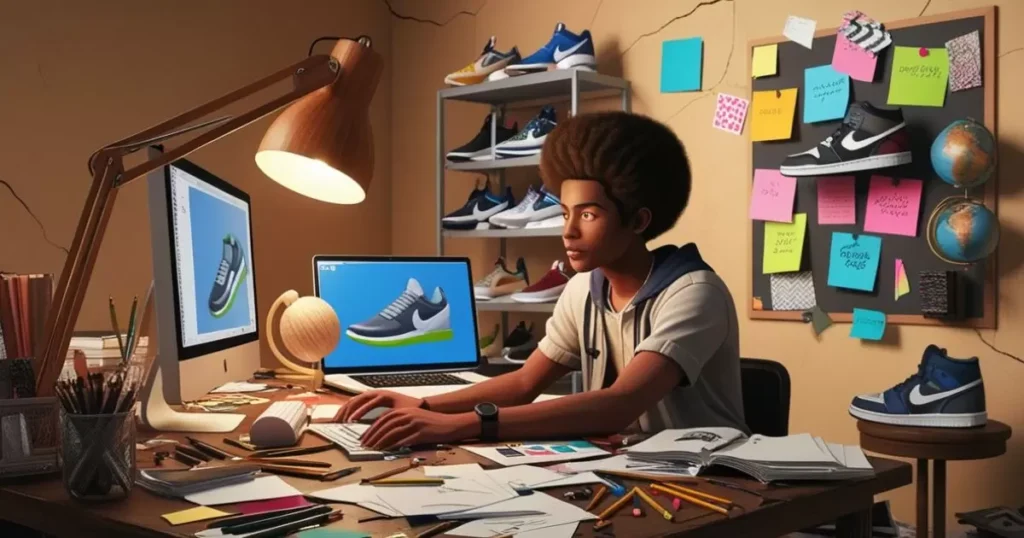In the world of footwear, sneakers reign supreme. They’re not just shoes; they’re a cultural phenomenon, a canvas for self-expression, and a technological marvel. But have you ever wondered how these iconic shoes come to life? Let’s lace up and take a deep dive into the fascinating world of sneaker production.
The Evolution of Sneakers: From Function to Fashion
Birth of the Athletic Shoe
The story of sneakers begins in the 19th century with a simple idea: rubber-soled shoes for comfort and grip. The first true sneaker, the “Plimsolls,” hit the scene in the 1830s. These canvas shoes with rubber soles were a far cry from today’s high-tech footwear, but they laid the groundwork for a revolution.
Key Innovations Through the Decades
- 1890s: Goodyear introduces vulcanized rubber, dramatically improving durability.
- 1920s: Converse All-Stars debut, becoming the first mass-market basketball shoe.
- 1960s: The running boom kicks off, spurring advancements in cushioning and support.
- 1980s: Air cushioning technology takes flight, changing the game forever.
- 2000s: Knit uppers and 3D-printed components enter the scene.
Today’s Sneaker Culture
Sneakers have transcended their athletic origins to become a cornerstone of fashion and pop culture. Limited editions fetch astronomical prices, and collaborations between brands and artists are eagerly anticipated events. The global sneaker market is expected to reach $120 billion by 2026, according to Statista.
Behind the Scenes: The Sneaker Design Process

Market Research and Trend Analysis
Before pencil hits paper, designers immerse themselves in the world of their target audience. They study fashion trends, cultural movements, and technological advancements. This research shapes the direction of new designs and ensures relevance in a fast-moving market.
Concept Sketching and 3D Modeling
With inspiration in hand, designers start sketching. These rough concepts evolve into detailed drawings and eventually 3D models. Software like Autodesk Fusion 360 allows designers to manipulate every aspect of the shoe in a virtual environment.
Performance Requirements vs. Aesthetic Appeal
“The perfect sneaker is a balance between form and function.” – Tinker Hatfield, legendary Nike designer
Designers walk a tightrope between creating a shoe that performs well and one that looks great. For performance sneakers, factors like weight, flexibility, and support are crucial. Fashion-focused designs might prioritize unique materials or eye-catching silhouettes.
The Role of Athlete Input and Biomechanics
Top-tier athletic sneakers often involve close collaboration with professional athletes. Motion capture technology and pressure-mapping tools provide insights into how the foot moves during specific activities, informing design decisions that can enhance performance and reduce injury risk.
Material Matters: Choosing the Building Blocks
Upper Materials: From Canvas to High-Tech Synthetics
The upper is the part of the shoe that encases the foot. Materials have come a long way from simple canvas:
- Flyknit: Nike’s proprietary knit material reduces waste and provides a sock-like fit.
- Primeknit: Adidas’ answer to Flyknit, offering similar benefits.
- Engineered mesh: Breathable and flexible, popular in running shoes.
- Synthetic leather: Durable and often more affordable than real leather.
Midsole Magic: Cushioning Technologies
The midsole is where the magic happens for comfort and performance:
| Technology | Brand | Key Features |
| Air | Nike | Pressurized air in flexible membranes |
| Boost | Adidas | Expanded thermoplastic polyurethane (eTPU) |
| Gel | ASICS | Silicone-based cushioning |
| Fresh Foam | New Balance | Precision-engineered single piece of foam |
Outsole Options: Traction and Durability
The outsole is the shoe’s point of contact with the ground. Materials and tread patterns vary based on the shoe’s intended use:
- Carbon rubber: Highly durable, used in high-wear areas.
- Blown rubber: Lighter and more flexible, often used in running shoes.
- Gum rubber: Offers excellent traction, popular in basketball and skateboarding shoes.
Sustainable Alternatives Shaking Up the Industry
As environmental concerns grow, brands are innovating with eco-friendly materials:
- Recycled ocean plastic: Adidas partnered with Parley for the Oceans to create shoes from reclaimed marine plastic.
- Algae-based foam: Brands like Vivobarefoot use algae-based EVA foam in their soles.
- Plant-based leathers: Materials like Piñatex, made from pineapple leaf fibers, offer leather alternatives.
From Sketch to Sample: Prototyping and Testing
3D Printing Revolutionizes Prototyping
3D printing has dramatically sped up the prototyping process. Designers can now produce physical models of their designs in hours rather than weeks, allowing for rapid iteration and testing.
Wear-Testing Protocols
Before a shoe goes into production, it undergoes rigorous testing:
- Lab tests: Machines simulate years of wear in days.
- Athlete testing: Professional and amateur athletes put prototypes through their paces.
- Environmental testing: Shoes are exposed to extreme conditions to ensure durability.
Iterative Design: Refining for Perfection
Based on test results, designers refine their creations. This process might involve tweaking the shape of the sole, adjusting the fit of the upper, or fine-tuning material choices. It’s not uncommon for a shoe to go through dozens of iterations before reaching its final form.
The Manufacturing Journey: Step by Step
Pattern Cutting: Precision is Key
The first step in physical production is cutting the shoe’s components. Computer-controlled cutting machines ensure precision and minimize waste. For some high-end or limited-edition sneakers, this process may still be done by hand.
Stitching and Lasting: Shaping the Upper
Skilled workers or advanced machines stitch the upper components together. The upper is then stretched over a foot-shaped last to give it its final shape. This process, known as lasting, is crucial for achieving the right fit.
Midsole Formation: Injection Molding and Compression
Midsoles are typically created through one of two processes:
- Injection molding: Liquid foam is injected into a mold and allowed to expand and set.
- Compression molding: Pre-formed foam pellets are heated and compressed into the desired shape.
Outsole Attachment: Vulcanization vs. Cementing
Two primary methods are used to attach the outsole:
- Vulcanization: The rubber sole is chemically bonded to the upper using heat and pressure. This creates a very durable bond but limits design options.
- Cementing: The outsole is glued to the midsole and upper. This allows for more design flexibility and is the most common method in modern sneaker production.
Final Assembly: Bringing it All Together
In the final stages, the insole is inserted, laces are added, and any finishing touches like logos or tags are applied. Each shoe undergoes a visual inspection before being paired, boxed, and prepared for shipping.
Quality Assurance: Ensuring Excellence
Material Testing Standards
Before production begins, all materials undergo rigorous testing:
- Tensile strength: How much force the material can withstand before breaking.
- Abrasion resistance: How well the material stands up to repeated friction.
- Color fastness: Ensuring dyes don’t fade or bleed.
Structural Integrity Checks
Throughout production, shoes are randomly selected for structural testing:
- Flex tests: Machines repeatedly bend the shoe to simulate walking or running.
- Impact tests: Dropping weights on the shoe to test cushioning and durability.
- Water resistance: For shoes designed to be waterproof or water-resistant.
Performance Validation
The final product must live up to its performance claims. This might involve:
- Traction tests on various surfaces
- Energy return measurements for running shoes
- Stability assessments for basketball shoes
The Green Revolution in Sneaker Production

Recycled Materials Making Waves
Brands are increasingly incorporating recycled materials into their shoes:
- Nike Grind: A material made from manufacturing scraps and worn-out sneakers.
- Recycled polyester: Often sourced from plastic bottles.
- Recycled rubber: Used in outsoles to reduce virgin rubber consumption.
Water Conservation and Chemical Reduction
The sneaker industry is notorious for its water usage and chemical-intensive processes. Innovations are addressing these issues:
- Waterless dyeing: DyeCoo’s CO2-based dyeing process uses no water and 95% fewer chemicals.
- Bio-based adhesives: Replacing petroleum-based glues with plant-derived alternatives.
Circular Economy Initiatives in Footwear
Some brands are embracing the concept of a circular economy:
- Adidas Futurecraft.Loop: A 100% recyclable shoe designed to be returned and remade into new shoes.
- On Cyclon: A subscription service where worn shoes are returned, recycled, and replaced with new ones.
The Art of Sneaker Marketing
Cultivating Brand Identity Through Design
A sneaker’s design is often its most powerful marketing tool. Iconic elements like Nike’s Swoosh or Adidas’ Three Stripes are instantly recognizable, embodying the brand’s identity and values.
The Power of Storytelling in Sneaker Launches
Every great sneaker has a story. Brands craft narratives around their products, tying them to athletes, cultural moments, or innovative technologies. These stories create emotional connections with consumers and drive hype.
Limited Editions and Artificial Scarcity
The concept of scarcity is a powerful marketing tool in the sneaker world. Limited edition releases create a sense of exclusivity and urgency, driving demand and commanding premium prices.
Case Study: Nike Air Yeezy 2 “Red October”
- Released without warning in 2014
- Sold out in 11 minutes
- Original retail price: $245
- Resale value: $10,000+
Leveraging Social Media and Influencer Culture
Social media has revolutionized sneaker marketing. Brands use platforms like Instagram and TikTok to build anticipation for new releases. Collaborations with influencers and celebrities help reach new audiences and add cultural cachet to products.
From Factory to Feet: Distribution Channels
The Rise of Direct-to-Consumer Models
Many sneaker brands are shifting towards direct-to-consumer (DTC) sales:
- Benefits: Higher profit margins, direct customer relationships, more control over brand presentation
- Challenges: Requires significant investment in e-commerce infrastructure and marketing
Brick-and-Mortar Experiences in the Digital Age
Despite the growth of online sales, physical stores remain important:
- Flagship stores: Showcase the brand’s full range and provide immersive experiences
- Pop-up shops: Create buzz and offer limited-time experiences
- Specialty retailers: Cater to sneaker enthusiasts with curated selections
Sneaker Apps and the Secondary Market
Mobile apps have become a crucial part of the sneaker ecosystem:
- Brand apps: Nike SNKRS, adidas Confirmed – used for exclusive releases and content
- Resale platforms: StockX, GOAT – facilitate the thriving secondary market for rare and limited-edition sneakers
Innovations Shaping the Future of Sneaker Production
3D-Printed Custom Fits
Brands like Adidas are experimenting with 3D-printed midsoles that can be customized to an individual’s foot shape and gait. This technology promises a new level of personalization and performance.
Smart Sneakers and Wearable Tech Integration
The line between sneakers and tech is blurring:
- Under Armour HOVR: Embedded sensors track running metrics
- Nike Adapt: Self-lacing technology adjusts fit on the fly
Automation and Robotics in Manufacturing
Automated production lines are becoming more common, promising increased efficiency and consistency:
- Adidas Speedfactory: Highly automated facilities capable of producing shoes in hours rather than months
- Robotic stitching: Machines capable of complex stitching patterns with high precision
On-Demand Production to Reduce Waste
The future of sneaker manufacturing may be local and on-demand:
- Customization: Shoes produced to order, reducing overstock
- Local production: Smaller, more agile factories closer to consumers
The Global Impact of Sneaker Manufacturing
Economic Effects on Production Hubs
Sneaker production has been a significant economic driver in countries like China, Vietnam, and Indonesia. As brands seek to diversify their supply chains and bring production closer to consumers, the economic landscape is shifting.
Addressing Labor Concerns and Ethical Manufacturing
The industry has faced criticism over labor practices. In response, many brands have implemented:
- Fair labor standards: Ensuring safe working conditions and fair wages
- Transparency initiatives: Publishing factory lists and audit results
- Worker empowerment programs: Education and skill development for factory workers
Environmental Challenges and Solutions
The sneaker industry faces significant environmental challenges:
- Carbon footprint: From raw material production to shipping
- Waste: Both in production and at the end of a shoe’s life
Solutions being implemented include:
- Renewable energy: Powering factories with solar and wind
- Recycling programs: Collecting and repurposing old sneakers
- Innovative materials: Developing biodegradable components
Conclusion: The Sneaker Industry’s Ongoing Evolution
The journey of a sneaker from concept to consumer is a complex dance of creativity, technology, and logistics. As the industry continues to evolve, we can expect to see even more innovation in design, manufacturing, and sustainability.
The future of sneakers promises to be as exciting as their past, with personalization, sustainability, and performance pushing the boundaries of what’s possible. Whether you’re a casual wearer or a dedicated sneakerhead, the shoes on your feet are the result of an incredible process that spans the globe and pushes the limits of design and technology.
As consumers become more conscious of the impact of their purchases, the sneaker industry is poised to lead the way in responsible manufacturing and innovative solutions to global challenges. The next time you lace up, take a moment to appreciate the artistry, engineering, and global effort that went into creating your perfect pair of kicks.
Frequently Asked Questions
Q: What are the main components of a sneaker?
A: The main components are the upper (covers the foot), midsole (provides cushioning), outsole (bottom layer for traction), and various smaller parts like laces, eyelets, and insoles.
Q: How long does it take to manufacture a pair of sneakers?
A: On average, it takes about 60 minutes of labor to produce a pair of sneakers. However, the entire process from design to retail can take several months to over a year.
Q: What materials are commonly used in sneaker production?
A: Common materials include synthetic leather, mesh, knit fabrics, rubber, foam (like EVA or polyurethane), and various plastics. Some sneakers also use natural materials like leather or canvas.
Q: Are most sneakers still made by hand?
A: While some parts of the process are automated, many steps in sneaker production still require skilled human labor, especially in stitching and assembly. However, automation is increasing in the industry.
Q: How are sneaker soles attached to the upper?
A: The two main methods are vulcanization (heat-bonding the rubber sole to the upper) and cementing (using strong adhesives to glue the sole to the upper). The method used depends on the sneaker design and intended use.

An author is a creator of written content, producing works ranging from books and articles to blog posts and essays. They use their creativity, knowledge, and research to inform, entertain, or persuade readers. Authors often have a unique voice and perspective, contributing significantly to literature and various media.

